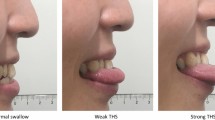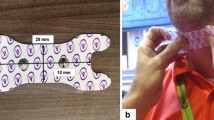Abstract
The aim of this study was to establish the reproducibility of tongue strength measurements in healthy women and men during maximum anterior isometric pressure (MAIP) and regular effort saliva swallows (RESS). In this cross-sectional study, 30 healthy young adults were required to push with the tip of the tongue on a piezo-resistive sensor glued to the hard palate, immediately above the central incisor line. Tongue pressures exerted on the sensor during MAIP and spontaneous RESS were recorded. Participants underwent a retest procedure within the same session to verify the reproducibility of measurements, as determined by intraclass correlation coefficient (ICC), standard error of measurement (SEM), and minimum detectable change (MDC). Complete data were obtained from 30 subjects (15 women, 15 men; mean age 31.4 ± 7.8 years; mean weight 61.3 ± 9.4 kg). Compared to women, men showed a trend for generating larger MAIP (p = 0.06; d = 0.71) and RESS (p = 0.07; d = 0.69). After normalizing to body weight, height, and body mass index (BMI), such trends disappeared. At retest, MAIP and RESS proved stable and highly reliable (all ICCs ≥ 0.93) in men and women but associated to moderate variability as for SEM and MDC, with MAIP estimates associated to smaller SEM and MDC (SEM ranging 7.4–14.2%; MDC 18.6–20.9%) than RESS (SEM ranging 20.4–38.5%; MDC 52.5–55.6%). Piezo-resistive pressure sensors allow clinicians and researchers to perform reproducible measurements of tongue muscle performance. However, if therapeutic interventions are administered, measurement variability in tongue performance should be considered when appraising their clinical efficacy, especially for those populations who display impaired performance and may not be capable to generate high and stable forces. No gender-based differences emerged in the motor tasks tested.


Similar content being viewed by others
References
Dodds WJ. Physiology of swallowing. Dysphagia. 1989;3:171–8.
Youmans SR, Stierwalt JA. Measures of tongue function related to normal swallowing. Dysphagia. 2006;21:102–11.
Sangave A, Manuccia T, Kay M, Zderic V (2008) Lingual force detection system. In: 2008 30th annual international conference of the IEEE engineering in medicine and biology society, pp 4844–4847
Burkhead LM, Sapienza CM, Rosenbek JC. Strength-training exercise in dysphagia rehabilitation: principles, procedures, and directions for future research. Dysphagia. 2007;22:251–65.
Iannuzzi-Sucich M, Prestwood KM, Kenny AM. Prevalence of sarcopenia and predictors of skeletal muscle mass in healthy, older men and women. J Gerontol A. 2002;57:M772-777.
Brown WF, Strong MJ, Snow R. Methods for estimating numbers of motor units in biceps-brachialis muscles and losses of motor units with aging. Muscle Nerve. 1988;11:423–32.
Robbins J, Kays SA, Gangnon RE, Hind JA, Hewitt AL, Gentry LR, Taylor AJ. The effects of lingual exercise in stroke patients with dysphagia. Arch Phys Med Rehabil. 2007;88:150–8.
Wood LM, Hughes J, Hayes KC, Wolfe DL. Reliability of labial closure force measurements in normal subjects and patients with CNS disorders. J Speech Hear Res. 1992;35:252–8.
Chakraborty P, Chandra P, Tandon R, Singh K, Chauhan A. Devices used for measuring tongue force: a review. Int J Orthod Rehabil. 2020;11:16.
Mortimore IL, Fiddes P, Stephens S, Douglas NJ. Tongue protrusion force and fatiguability in male and female subjects. Eur Respir J. 1999;14:191–5.
Robin D, Goel A, Somodi L, Luschei E. Tongue strength and endurance: relation to highly skilled movements. J Speech Hear Res. 1992;35:1239–45.
O’Day C, Frank E, Montgomery A, Nichols M, McDade H. Repeated tongue and hand strength measurements in normal adults and individuals with Parkinson’s disease. Int J Orofac Myol. 2005;31:15–25.
Adams V, Mathisen B, Baines S, Lazarus C, Callister R. Reliability of measurements of tongue and hand strength and endurance using the Iowa Oral Performance Instrument with healthy adults. Dysphagia. 2014;29:83–95.
Adams V, Mathisen B, Baines S, Lazarus C, Callister R. A systematic review and meta-analysis of measurements of tongue and hand strength and endurance using the Iowa Oral Performance Instrument (IOPI). Dysphagia. 2013;28:350–69.
Liu HY, Chen CH, Kuo CH, Feng MC, Chen JH, Wang HW, Chen KC, Lin CL. A novel tongue pressure measurement instrument with wireless mobile application control function and disposable positioning mouthpiece. Diagnostics (Basel). 2021;11:489.
Tamine K, Ono T, Hori K, Kondoh J, Hamanaka S, Maeda Y. Age-related changes in tongue pressure during swallowing. J Dent Res. 2010;89:1097–101.
Furuya J, Nakamura S, Ono T, Suzuki T. Tongue pressure production while swallowing water and pudding and during dry swallow using a sensor sheet system. J Oral Rehabil. 2012;39:684–91.
Xu K, Zeng J, Xu T. Effect of an intraoral appliance on tongue pressure measured by force exerted during swallowing. Am J Orthod Dentofac Orthop. 2016;149:55–61.
Beckerman H, Roebroeck ME, Lankhorst GJ, Becher JG, Bezemer PD, Verbeek AL. Smallest real difference, a link between reproducibility and responsiveness. Qual Life Res. 2001;10:571–8.
de Vet HC, Terwee CB, Mokkink LB, Knol DL. Measurement in medicine. A practical guide. Cambridge: Cambridge University Press; 2011.
Miller AE, MacDougall JD, Tarnopolsky MA, Sale DG. Gender differences in strength and muscle fiber characteristics. Eur J Appl Physiol Occup Physiol. 1993;66:254–62.
Clark HM, Henson PA, Barber WD, Stierwalt JA, Sherrill M. Relationships among subjective and objective measures of tongue strength and oral phase swallowing impairments. Am J Speech Lang Pathol. 2003;12:40–50.
Shrout PE, Fleiss JL. Intraclass correlations: uses in assessing rater reliability. Psychol Bull. 1979;86:420.
Scoppa F, Saccomanno S, Bianco G, Pirino A. Tongue posture, tongue movements, swallowing, and cerebral areas activation: a functional magnetic resonance imaging study. Appl Sci. 2020;10:6027.
Fei T, Polacco RC, Hori SE, Molfenter SM, Peladeau-Pigeon M, Tsang C, Steele CM. Age-related differences in tongue-palate pressures for strength and swallowing tasks. Dysphagia. 2013;28:575–81.
Jaric S. Muscle strength testing: use of normalisation for body size. Sports Med. 2002;32:615–31.
Cohen J. Statistical power analysis for the behavioral sciences. 2nd ed. Hillsdale: Lawrence Earlbaum Associates; 1988.
Gingrich LL, Stierwalt JA, Hageman CF, LaPointe LL. Lingual propulsive pressures across consistencies generated by the anteromedian and posteromedian tongue by healthy young adults. J Speech Lang Hear Res. 2012;55:960–72.
Furlan L, Sterr A. The applicability of standard error of measurement and minimal detectable change to motor learning research—a behavioral study. Front Hum Neurosci. 2018;12:95.
Clark HM, Solomon NP. Age and sex differences in orofacial strength. Dysphagia. 2012;27:2–9.
Park JS, Oh DH, Chang M. Comparison of maximal tongue strength and tongue strength used during swallowing in relation to age in healthy adults. J Phys Ther Sci. 2016;28:442–5.
Roubenoff R. Sarcopenic obesity: the confluence of two epidemics. Obes Res. 2004;12:887–8.
Acknowledgements
We are indebted to Dr. Giovanni Spano, MD, PhD for providing clinical and technical support and guidance.
Funding
Drs. Gianluca Martinez and Lucia Ventura are supported by Fondazione Italiana Sclerosi Multipla [Grant Number: FISM 2018/R/9].
Author information
Authors and Affiliations
Corresponding author
Ethics declarations
Conflict of interest
All authors declare that they have no conflict of interest.
Ethical Approval
All procedures performed in studies involving human participants were in accordance with the ethical standards of the Institutional Research Committee and with the 1964 Helsinki declaration and its later amendments or comparable ethical standards.
Additional information
Publisher's Note
Springer Nature remains neutral with regard to jurisdictional claims in published maps and institutional affiliations.
Rights and permissions
About this article
Cite this article
Martinez, G., Ventura, L., Cugusi, L. et al. Healthy Women and Men Do Not Show Differences in Tongue Strength and Regular Effort Saliva Swallows as Assessed by Piezo-Resistive Sensors: Results from a Reproducibility Study. Dysphagia 37, 1217–1225 (2022). https://doi.org/10.1007/s00455-021-10381-6
Received:
Accepted:
Published:
Issue Date:
DOI: https://doi.org/10.1007/s00455-021-10381-6




